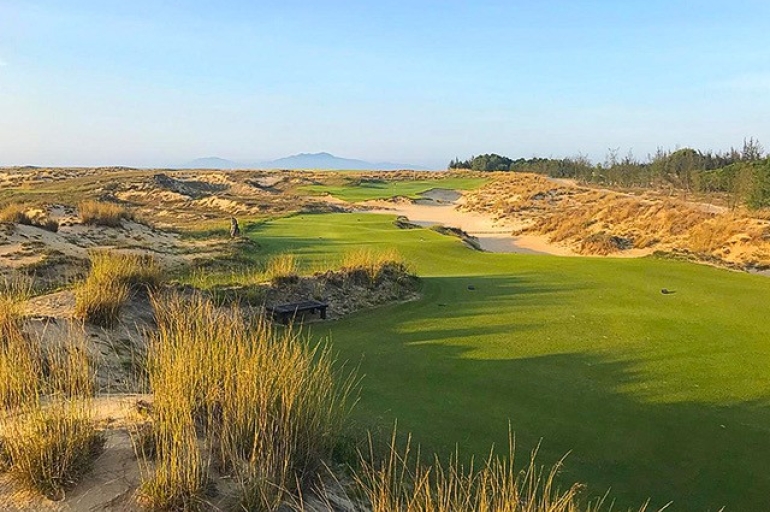
Asia's New Golfing Tiger
Golf first came to Vietnam a surprisingly long time ago.
The French colonial authorities planned the hill station of Dalat, in the country’s Central Highlands, in the aftermath of the First World War, and when the architect and urban planner Ernest Hébrard laid out the first masterplan of the new resort in 1922, a golf course was included.
The course was not built at that time, but it was certainly in operation by 1932, when Bao Dai, the last emperor of Vietnam, returned to his homeland from France, where he seems to have discovered the game. In 1930, the British design firm of Colt, Alison and Morrison published a four-page marketing flyer, listing all the courses on which they had worked. At the very bottom of the fourth page, the words ‘Indo China: Ville de Dalat’ were to be found.
Harry Colt, who was 60 in 1929, certainly never travelled to Dalat to design the course. Nor, almost certainly, did his younger and seemingly more nomadic colleague Hugh Alison. Alison was in Asia, in Japan, between October 1930 and April 1931, and it is just
about conceivable that he could have taken a ship from Tokyo to Saigon at the back end of his trip, but it is very, very hard to believe, as the timings really do not add up, and there is no mention of Alison’s Japanese work in the marketing flyer. Much more likely is that Colt or Alison laid out the course from topographical maps, as they did for a number of other far-flung projects, at some point in the late 1920s. The course has long been rumoured to have been constructed for Bao Dai, though according to Vietnam resident Adam Calver, now chief operating officer of Faldo Design, the emperor did apparently build a small course near the coastal city of Hue, the country’s capital between 1802 and 1945; but it has long been out of use.
Dalat was abandoned for the first time in 1945. Around the same time as it was constructed, another course came into being, the Saigon, or Go Vap Golf Club, and that continued in use, even after Dalat was abandoned. In the late 1950s, a doctor named Dao Huy Hach led the restoration of the Dalat course, drawing on the resources of the Saigon club, but in 1975, the course ceased to exist again. It was finally restored to play in its present form in 1994, in a project financed by Larry Hillblom, the founder of DHL. During this period, Vietnam’s first modern course, the Vietnam Golf & Country Club in Ho Chi Minh City (formerly Saigon) came into being. And since then, golf has spread up and down Vietnam.
Originally, the logic behind golf in Vietnam was tourism. The country – which The Times recently called ‘Asia’s most intoxicating’ – is one of the world’s fastest-growing tourist destinations. From 2.1 million international visitors in 2000, Vietnam received 18 million in 2019, although it has dipped below 13 million post pandemic. South Korea, a golfing hotbed, is Vietnam’s largest source of guests. And it is obvious that firstly, a proportion of those tourists will be golfers, and secondly, as elsewhere in the world, that golfing visitors are, on average, high spenders. Within Asia, Thailand is, as is well known, the most successful golf tourism destination, with around 800,000 tourists visiting the country to play golf. China’s Hainan Island was another attempt to create an Asian golf tourism hub, but the country’s anti-corruption drive saw a severe crackdown on golf development, and consequently Hainan has fallen out of the headlines. Given the growth of tourism in Vietnam, and the country’s natural attributes – the country has 3,260 kilometres (2,000 miles) of coastline – it is hardly surprising that golf became a subject of conversation.
Globetrotting architect Brian Curley, now of the newly-formed Curley- Wagner firm, says: “I first went to Vietnam in about 2015. China had hit the buffers, and I had to pick up my ball and go somewhere else to do business. I had been hearing ‘Vietnam is going to build golf’ for some time, and I picked up a job designing the Stone Valley course in Hanoi. On my first visit, I checked into my hotel, and bumped into the hotel’s general manager, who saw my roll of plans and asked me what I did. I said, ‘I’m building a golf course.’ He said, ‘Oh please, build me a golf course. I have so many people asking about golf, and there’s nowhere to play’.”
"From a tourist standpoint, Vietnam has the potential to be a hub for southeast Asia,” says Adam Calver of Faldo Design, who moved to the country in 2017 to run the course at Laguna Lang Co, which was designed by the Faldo firm and opened in 2013. “It has diversity in terrain – as well as the coastal stuff there could be great mountain golf. But in recent years, the balance of play has changed. At Laguna, Covid tripled our domestic golf demand – we went from ten per cent Vietnamese golfers to 30 or 40. Covid saw players start to bring their families to the golf course in numbers, and junior golf has started to grow a lot. The Vietnam Golf Association has launched a junior golf tour in partnership with the R&A, and the Faldo Series final has been here since 2017. There are a lot of very good Vietnamese juniors now. The growth of golf among the Vietnamese goes hand in hand with the overall economic growth of the country.” Mike Gorman of Robert Trent Jones II, who was the lead architect on the firm’s Hoiana Shores project near the city of Da Nang, about halfway down the Vietnamese coast, echoes the same message. “The original market for Hoiana was tourists, principally Korean and Japanese,” he says. “However, what has happened is that it is such a fast-developing country that there has been a local golf boom among the Vietnamese. But the tourist market is still strong. Every time I land in the Da Nang airport there could be 20, 30 or 40 golf bags being unloaded off the plane.”
Curley says: “Every course in the Hanoi or Ho Chi Minh City areas is rammed full of locals, to the tune of about 200 rounds a day. You hardly see any expats playing.” As a result, there are substantial numbers of courses in development, though exactly how
many depends on who you talk to. “There are 65-70 courses operational in the country now, with perhaps a dozen in active construction,” says Calver. “We hear that there are a hundred courses in planning, but I don’t believe that is realistic,” says Gorman. But there is no doubt that, as elsewhere in Asia, developers are building for the future and accepting that, in the early days, their courses may lose money.
“Everything in Asia is built ahead of the curve,” says Curley. “Construction costs are comparable with the rest of the world, they might be three- quarters of what you would spend everywhere else, but operations are extremely cheap. If you’re ahead of the curve at some resort in Vietnam, and it is going to take five years before you have enough golfers, you aren’t losing that much money. It is cheap to maintain a golf course there, because labour is cheap, so you can wait.
Generally, in Vietnam, water is cheap. You aren’t trying to get water to the course, you’re trying to get it off the course through drainage rather than huge and expensive irrigation systems. Many projects rely on surface water – you dig a lake, route the drainage to it and you get your own water. You tend to get water year-round, so most of the time your lakes look like lakes. You can get to sites, dig a hole two metres deep, and it’s sloshing with water. Even on the sand dune sites at the beach, there’s water.”
Curley’s mention of sand dunes brings us to what makes Vietnam a truly exciting country for golf. Just glancing at the map shows how long the country’s coastline is, and quite a bit of it is sandy. “Vietnam is a spectacular country. There is an energy and vibrancy to the country unlike anywhere else I’ve ever been. When you look at the coastline from about Hue past Da Nang and going another 200- 300 miles, it is all sand, some of the best dunesland anywhere,” says Gorman.
“If you go straight across the water from Hanoi, you’re in mudflats,” says Curley. “But at a 45-degree angle south, you hit the sand, and it is mostly all sand down the coast. I’ve seen some of the best sites I have ever seen. You basically have two kinds of sites, those along the coast, and on the lower parts of the mountains, Sand dunes that are not used for agriculture. The rice lands are protected. You’re either at the beach or you’re in the rocky hills.”
Calver adds: “I drove from Dung Hoi to Ho Chi Minh, basically hiking over sand dunes. There is phenomenal coastline and a lot of sand. Some have rock mixed in with the sand but there could be a considerable amount of great coastal golf courses.”
There are already plenty of good courses along the Vietnamese coast. The best, according to Top 100 Golf Courses rankings, is the Bluffs Ho Tram Strip, designed by Greg Norman’s practice and part of a large casino resort, 80 miles south-east of Ho Chi Minh City. The course explores enormous, 50-metre-high sand dunes, and every hole has a view of the sea, but they do not actually touch the water; that land has been reserved for future development.
The Jones-designed Hoiana Shores, ranked second, does have some golf along the coastline; it is also part of a large resort (as far as we have been able to discern, all the golf in Vietnam is public). The Jones firm, Gorman says, has two further projects in development in Vietnam, one near Hanoi, the other outside Ho Chi Minh City.
“I first went to Vietnam in 2005/6 with Tony Cashmore and Tom Phillips of the Faldo group – Tony was doing work for Faldo in Australia,” says South African architect Paul Jansen. “Tom got a couple of leads and called me to say, ‘We have a few potential projects in Vietnam’. A few weeks later I was there.
“We toured a couple of sites, including the one that became Laguna Lang Co. We completed the drawings a year or two later and it broke ground in 2009. At that time the road only reached the top of the mountain and we had to walk all the way down to the site. A few months before, the only way the site was accessible was by boat. But it was stunning – we drew a lot of our inspiration from the surroundings. A third of the site was rice paddy fields, so quite wet, and we had to do some clearing in the jungle areas.”
According to Calver, the Faldo firm now has two new projects in the country, Royal Long An near Ho Chi Minh City, with 18 holes open and nine in rough shaping, and Silk Path near Hanoi, which has started grassing and has a third nine in planning.
“The golf courses in Thailand don’t have the natural settings that Vietnam has, but the operations are nailed down,” says Curley. “In Vietnam, the courses are there, but the operations are behind. When they figure that out, they are going to be impossible to beat.”


